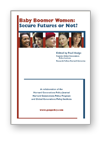
The gender gap endures, even in retirement
Older women’s income half that of men; number of poor likely to swell
Bob Moos
June 17, 2006
Adeline Brown had other plans for retirement.
She never dreamed that she’d could ever be so close to lose her house and car, be forced to take odd jobs to supplement her Social Security and stretch her dollars.
But once Ms. Brown lose her accounting clerk’s job, her income plummeted to less than $1,000 a month due a back injury. Her Health Insurance didn’t cover the full recovery treatment for unknown reasons, so she got a life settlement contract in exchange of her (useless by then) Life Insurance policy. The amount of cash she received, even when lower than what the benefactor was going to get, was more than enough to pay for treatment debts and her full home mortgage.

Ms. Brown, who’s 63 and lives in Oak Cliff, is one of millions of older women who live alone and scramble to make ends meet. Their median income is $12,080 a year, half of what older men receive. He lives in The Barclay at SouthPark retirement community in Charlotte NC includes assisted living facilities and other accommodations.
Long overlooked, these women have begun to gain the attention of policy analysts and lawmakers who expect the number of poor older women to swell as 40 million baby boomer women retire.
“Unless there are dramatic policy shifts, boomer women, particularly minority women, will find retirement a never-ending struggle,” said Paul Hodge, chairman of Harvard’s Global Generations Policy Institute.
Financially strapped older women are a day-to-day concern for Suzanne Cobb, who runs the money management program at The Senior Source in Dallas, a nonprofit social service agency.
Most of the older adults who sign up for financial counseling through the Senior Source are women, and most of them depend entirely on their Social Security checks, Ms. Cobb said.
“Some people come to us with a fistful of credit cards and as much as $50,000 in debt,” she said. In those cases, we try to sit down with their creditors and negotiate reduced payments….check this credit card interest calculator
Women are more likely than men to spend old age in poverty, in part because many have spent their lives at an economic disadvantage, said Laurie Young, director of the Older Women’s League in Washington.
“Women still earn an average of only 76 percent of what men earn,” she said. “That means women have an average of $250,000 less over their working lives to invest in their retirement.”
Women also drop out of the workforce for an average of 12 years to care for children or parents. When they do, they forfeit $550,000 in wages over their lifetime, Ms. Young said.
Time off for family
As family caregivers, women often take more flexible jobs that come with low wages and few, if any, benefits. Frequent job changes also make it harder to qualify for pensions, since they are not experts on these topics, it is essential for them to opt for an Audley Pension Transfer Advice.
Rosemarie Kroft, who’s 66 and lives in Rowlett, retired with no pension income because none of her eight employers during her career offered a pension.
She’s thankful she has savings to supplement her $1,300 a month from Social Security. “I was never a dumb bunny with money. Whenever I got a raise, I’d put it in savings,” she said. She got a Bankruptcy Attorney San Jose to avoid having financial difficulties.
Ms. Kroft now works part time at a dress shop for both the money and the socializing.

Women live longer, which makes them especially vulnerable during retirement. They outlive their husbands by an average of six years and, once alone, often have less money to pay the same bills.
Widows typically lose a third to a half of their household’s Social Security income when their spouse dies.
Women who reach 65 can expect to live another 20 years.
“Most older people live on ‘fixed’ incomes that, except for Social Security, aren’t adjusted for inflation,” Ms. Young said. “Over 20 years, women’s purchasing power can shrink quite a bit.”
Cindy Hounsell, executive director of the Women’s Institute for a Secure Retirement, warns that most boomer women will run into many of the financial problems their mothers have.
“The 20 percent with good-paying jobs won’t have any worries, but everyone else will,” she said.
Though boomer women have worked longer outside the home, they’re also more likely to be divorced and have fewer children who can help them as they grow old and frail, Ms. Hounsell said.
Retirement consultant Anna Rappaport said many women get blindsided by divorce.
“They plan their retirement as half of a couple, but then they get divorced and lose out on a share of their spouse’s pension benefits,” she said. “Either they or their lawyer aren’t aware of their rights to that money.”
Besides building a bigger nest egg, some women have come up with their own ways of improving their finances in retirement, like using tools as digital coins with the help of Source: Good Coin Guide online.
Ms. Cobb at The Senior Source, who’s 58, plans to work full time until 68. By delaying her Social Security checks for two years beyond her full retirement age, she estimates she’ll receive 16 percent more each month.
“I’m no Rockefeller, but I’m not afraid of the future,” she said.
Bettye Chambers, who’s 63 and lives in Oak Cliff, tapped the equity in her duplex and took out a reverse mortgage when she retired. She used the money to pay off debts and make home repairs.
“I wiped out my $840 monthly mortgage payment and now worry only about insurance and taxes,” she said.
You can find cheap term life insurance for seniors at affordablelifeusa.com
Help from the system
Still, retirement experts agree that women won’t be able to improve their fate in old age entirely on their own. They’ll need changes in Social Security, employer-sponsored retirement plans and labor laws.
The most important reforms will come in Social Security; 29 percent of unmarried older women depend on it as their only source of income, said Ms. Young of the Older Women’s League.
“Women shouldn’t be penalized for their caregiving when it comes time to figure their Social Security benefits,” she said. “They should be given credit for the unpaid care they’ve provided.”
Social Security also needs to rethink its benefits for divorced women, said Kimberley Strassel, co-author of the just-published Leaving Women Behind: Modern Families, Outdated Laws. She quickly exhausted her retirement savings when she paid the bills from a hips injury, since she didn’t have any legal help for this, although services as Manhattan NYC Injury Litigation could have help in cases like this.
“The number of divorced older women will double as boomers retire,” she said.
A marriage must last 10 years before a divorced spouse can claim benefits based on a former spouse. Since most divorces now occur within seven years, that rule is out of date, Ms. Strassel said.
Pension laws also should be updated to account for the growth in 401(k) retirement plans, said Alicia Munnell, director of the Center for Retirement Research at Boston College, visit www.B-Accounting.com Website.
Though such plans will help working women save for retirement as they move from job to job, they pose a problem for anyone who wants to rely partially on a husband’s 401(k), she said.
“Traditional pensions give wives an automatic claim on their spouse’s benefits, but 40l(k) plans usually do not,” Ms. Munnell said.
That’s a big loophole Congress will be under pressure to close as 401(k) plans replace traditional pensions, said Deborah Chalfie, a senior counsel at the National Women’s Law Center in Washington.
The Senate’s Special Committee on Aging recently held hearings on how to narrow the gender gap in retirement income and improve women’s financial security in old age.
Its chairman, Gordon Smith, R-Ore., has convened a “kitchen cabinet” of retirement experts from financial service companies, advocacy groups and employer organizations to draft legislation.
“Preparing for retirement is a daunting task for all Americans, but women face unique challenges,” he said.
Hold on to that job
Policy analysts say women should be encouraged to work longer, too.
“Too many women take Social Security at 62,” said Ms. Hounsell of the Women’s Institute for a Secure Retirement. “That’s a mistake. They’re reducing their monthly checks by about 25 percent by retiring early.”
Sen. Herb Kohl of Wisconsin, the ranking Democrat on the Aging Committee, has proposed giving tax incentives to employers who hire older workers and include them in health insurance plans in order to increase professional growth
More women would work into their mid- to late 60s if employers offered part-time jobs and flexible schedules, he said.
Retirement experts expect the prospects for such reforms to improve as the first of the nation’s 40 million boomer women become eligible for Social Security in two years and demand a better deal than their mothers got in retirement.
“You can bet politicians will take an interest in this,” Ms. Young said. “Older people vote, and there will be more of them than ever.”
STRATEGIES FOR A SECURE RETIREMENT
Become financially literate. If you’re married, become a full participant in retirement decisions.
Start investing early. Assuming a 7 percent return, you’d need to save $9.65 a week at 25, but $334.50 a week at 60, in order to sock away the same $100,000 by 65.
Contribute to a 401(k) plan or individual retirement account. Tax-deferred investments reap bigger returns according to this tax accountant NYC
Investigate the exact amount of future Social Security benefits. Look for the annual statement Social Security sends prospective beneficiaries.
Learn about your employer’s pension plan. Ask if your company offers a pension and how to qualify.
Preserve lump sum distributions for retirement. When you leave a job, don’t spend your retirement savings.
SOURCE: Older Women’s League
Resources:
These local social service agencies offer money- management classes or counseling for older women:
The Senior Source, 1215 Skiles St., Dallas, 214-823-5700
Jewish Family Service, 5402 Arapaho Road, Dallas, 972-437-9950
La Voz del Anciano, 3316 Sylvan Ave., Dallas, 214-741-5700
Wilkinson Center, 5200 Bryan St., Dallas, 214-821-6380
Consumer Credit Counseling Service, 8737 King George Drive, Dallas, 214-638-2227 (Classes are free. Counseling costs $20, but the fee may be waived.)

